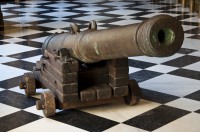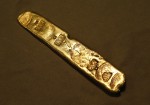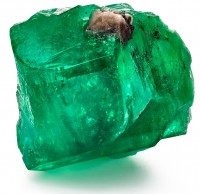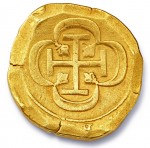In the wee hours of September 6th, 1622, the convoy of 28 ships in the Spanish Tierra Firme flota met the business end of a hurricane in the Florida straits. When the skies cleared and dawn broke, eight of the treasure ships were lost, smashed on the seabed, their glittering cargos strewn over 50 miles from the Marquesas Keys to what is now Dry Tortugas National Park.
 The Tierra Firme fleet, so named because it departed from the southern Spanish Main, or Tierra Firme province, on the Gulf of Mexico, was absolutely heaving with treasure that year. Hundreds of tons of gold, silver, copper, indigo, tobacco, emeralds, and pearls from Peru, Mexico, Colombia and Venezuela were transported to the coastal port cities of the Tierra Firme on mule trains. There was so much loot that inventorying it and loading it onto the ships delayed the expedition by six weeks, pushing the voyage into the peak of the Atlantic hurricane season. It took two months to load the Nuestra Señora de Atocha alone, and it was more heavily armed than the other ships of the fleet because it was the rear guard of the convoy–so it could “only” carry 40 tons of gold and silver and 70 pounds of emeralds from the Muzo mines of Colombia.
The Tierra Firme fleet, so named because it departed from the southern Spanish Main, or Tierra Firme province, on the Gulf of Mexico, was absolutely heaving with treasure that year. Hundreds of tons of gold, silver, copper, indigo, tobacco, emeralds, and pearls from Peru, Mexico, Colombia and Venezuela were transported to the coastal port cities of the Tierra Firme on mule trains. There was so much loot that inventorying it and loading it onto the ships delayed the expedition by six weeks, pushing the voyage into the peak of the Atlantic hurricane season. It took two months to load the Nuestra Señora de Atocha alone, and it was more heavily armed than the other ships of the fleet because it was the rear guard of the convoy–so it could “only” carry 40 tons of gold and silver and 70 pounds of emeralds from the Muzo mines of Colombia.
The Nuestra Señora de Atocha was one of the eight ships that went down in the hurricane. It was torn apart on a reef, its hull breached and keel broken in two. It sank in minutes after that, taking almost the entire crew with it. Only five men survived, three sailors and two slaves, because they had the presence of mind to tie themselves to the mizzenmast.
The Spanish tried to salvage what they could from the lost treasure galleons. One of the ships, the Santa Margarita, ran aground near where the Atocha sank. Using bronze diving bells and slaves to man them — many of whom died performing this incredibly dangerous job, as we know from the insurance claims filed so the owners could be reimbursed for the sale value of their human chattel — crews were able to recover about half of the Santa Margarita’s cargo. They knew the wreck of the Atocha was in the area somewhere, but the Spanish were never able to find it.
 Almost four centuries would pass before someone did. Treasure hunter Mel Fisher searched for 16 years for the wreck and finally hit paydirt in July of 1985. Fisher and his team recovered vast quantities of coins, silver and gold ingots and emeralds, even though the bulk of the gold and emeralds are believed to have been stored in the ship’s sterncastle which has never been found. After a decade of legal skirmishes with the State of Florida, the courts awarded Fisher full rights to all of the treasure of the Nuestra Señora de Atocha.
Almost four centuries would pass before someone did. Treasure hunter Mel Fisher searched for 16 years for the wreck and finally hit paydirt in July of 1985. Fisher and his team recovered vast quantities of coins, silver and gold ingots and emeralds, even though the bulk of the gold and emeralds are believed to have been stored in the ship’s sterncastle which has never been found. After a decade of legal skirmishes with the State of Florida, the courts awarded Fisher full rights to all of the treasure of the Nuestra Señora de Atocha.
Some of its riches are now on display in the Mel Fisher Maritime Museum on Key West. A selection of its most exceptional emeralds will be going up for auction on April 25th at Guernsey’s auction house in New York City. The gemstones belong to Manuel Marcial de Gomar, who started out working in the Chivor emerald mines of Colombia in 1955 when he was 19, opened the first emerald specialty store in 1964 and became one of the world’s leading emerald specialists.
 Fisher hired him to appraise all the emeralds from the Atocha, about seven pounds of them, recovered over the course of more than two decades. Appropriately, Marcial’s consulting fee was paid in emeralds. Emeralds from the Muzo mines are considered the best in the world for the richness of their blue-green color. Add the Atocha history and these stones become even more than the sum of their beautiful parts. Marcial selected some of the stones to be cut and set in jewelry of his design. Some he kept in their rough state.
Fisher hired him to appraise all the emeralds from the Atocha, about seven pounds of them, recovered over the course of more than two decades. Appropriately, Marcial’s consulting fee was paid in emeralds. Emeralds from the Muzo mines are considered the best in the world for the richness of their blue-green color. Add the Atocha history and these stones become even more than the sum of their beautiful parts. Marcial selected some of the stones to be cut and set in jewelry of his design. Some he kept in their rough state.
It’s one of the rough emeralds from the Nuestra Señora de Atocha which is the star player in the upcoming Marcial de Gomar Collection auction. La Gloria is an 887 carat rough emerald, bigger than the one in the Smithsonian (857 carats) and the one in New York’s Museum of Natural History (632 carats). The pre-sale estimate is $3,000,000-$5,000,000.
 Coming in close at its heels is a group of loose emeralds romantically dubbed the Nine Pillars of the Andes (pre-sale estimate $3,000,000-$4,000,000). From largest to smallest they weigh 26.72 carats, 15.54 carats, 11.65 carats, 9.82 carats, 7.77 carats, 6.68 carats, 6.45 carats, 4.56 carats, and 2.50 carats for a total of 91.69 carats.
Coming in close at its heels is a group of loose emeralds romantically dubbed the Nine Pillars of the Andes (pre-sale estimate $3,000,000-$4,000,000). From largest to smallest they weigh 26.72 carats, 15.54 carats, 11.65 carats, 9.82 carats, 7.77 carats, 6.68 carats, 6.45 carats, 4.56 carats, and 2.50 carats for a total of 91.69 carats.
Not to say there aren’t any bargains. For a mere $100,000-$125,000, you can score the Andina del Mar, a 2.51-carat round cut emerald Marcial cut from a 5.35 carat rough emerald. It’s the second largest known round faceted emerald recovered from the ocean. Or how about its pear shaped sister, the Lagrima de Atocha, a 1.61 carat emerald cut from a 4.41 carat rough gemstone, which is also estimated to sell for $100,000-$125,000.
 In addition to the emeralds, some coins recovered from the famous shipwreck are also part of the sale, like this Spanish eight escudo coin made of 22-karat gold. It’s a comparative bargain with a pre-sale estimate of $15,000-$20,000. This coin comes from the personal collection of Mel Fisher, as do several other gold coins going under the hammer at this auction, including a group recovered from the wreck of the 1715 Treasure Fleet.
In addition to the emeralds, some coins recovered from the famous shipwreck are also part of the sale, like this Spanish eight escudo coin made of 22-karat gold. It’s a comparative bargain with a pre-sale estimate of $15,000-$20,000. This coin comes from the personal collection of Mel Fisher, as do several other gold coins going under the hammer at this auction, including a group recovered from the wreck of the 1715 Treasure Fleet.